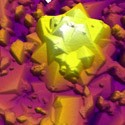NANOCOMPOSITES WITH IMPROVED OPTICAL AND MAGNETIC
PROPERTIES BY LASER SEQUENTIAL DEPOSITION

PROJECT DESCRIPTION The physical properties of nanocomposite materials consisting of nanoparticles (NP) embedded in a dielectric matrix material differ greatly from the respective bulk materials or from those of the nanoparticles themselves. Such nanocomposite (NC) materials present novel electrical, optical, magnetic and catalytic properties that are of great potential interest in applications. Some examples of such applications are all-optical switches, ultrahigh density magnetic recording media, efficient catalyzers or sensors. Nanocomposites in which certain metal nanoparticles are embedded in a transparent dielectric matrix have an enhanced nonlinear optical response and an ultrafast response time (subpicosecond). Other types of nanocomposite materials posess novel magnetic properties of considerable interest. We use sequential PLD for obtaining nanocomposites with improved optical and magnetic properties. This method consists in the successive PLD deposition of thin film and nanoparticles from the respective targets. In order to obtain control of the morphological, structural and functional properties of nanocomposites, the effect of several PLD parameters of primary importance will be studied. We will attempt to correlate these with the characteristics of species in the laser ablation plasma, since it is the various ionic and atomic species which, in the end, determine the properties of the NP and the deposited films. The effect of materials parameters will also be studied. An advantage of the method is that both of the constituents of the nanocomposite, the matrix and the nanoparticles, will be obtained using PLD, in successive steps of the same deposition, which simplifies the process, and ensures its flexibility and reproducibility. The final goal of the project is to obtain nanocomposites having improved optical and magnetic properties with applications in all-optical and nano-magnetic devices, using sequential PLD. The functional properties of the optical and magnetic NCs which are of interest for applications: extremely high third-order non-linear susceptibility (10-7 esu), optical response time in the ps regime, and, respectively, magnetic coercivities two orders of magnitude higher than the bulk, will be attained by optimizing the deposition and materials parameters in order to control NP and thin film characteristics. |